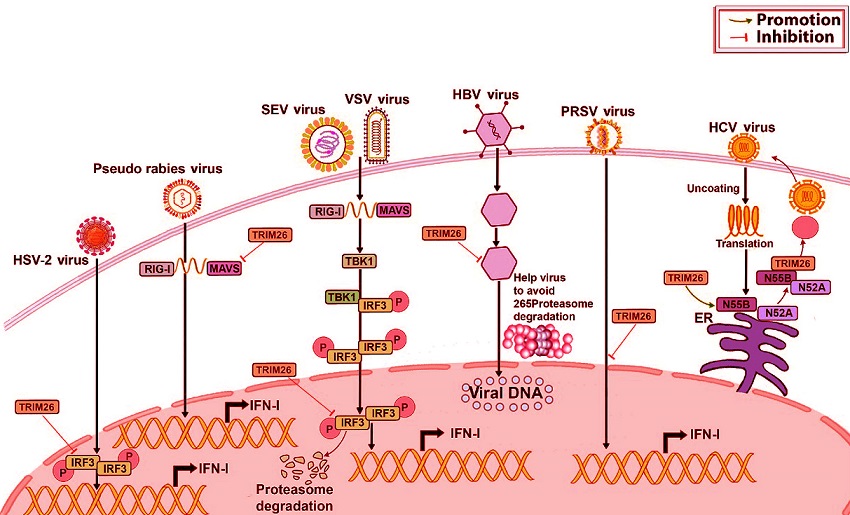Nikhil Prasad Fact checked by:Thailand Medical News Team Nov 17, 2024 4 months, 3 weeks, 5 days, 10 hours, 20 minutes ago
Medical News: Researchers from the Shanghai Veterinary Research Institute, part of the Chinese Academy of Agricultural Sciences, have delved deep into the multifaceted protein TRIM26. This E3 ubiquitin ligase, part of the TRIM protein family, plays critical roles in cellular defense and viral interactions. The study reveals a fascinating duality: TRIM26 can be either a guardian of the host immune response or a tool exploited by viruses to ensure their survival. This
Medical News report aims to shed light on these findings and their broader implications.
 TRIM26 functions as a suppressor of immune responses during a viral infection. The ubiquitination of IRF3 or its upstream sensors by TRIM26 results in immune suppression during viral infection. Ultimately, the replication of viruses, such as HSV-2, PRV, SEV, VSV, HBV, HCV, and PRRSV, is facilitated in a TRIM26-dependent manner.
The Structure of TRIM26: Building Blocks of Immunity
TRIM26 functions as a suppressor of immune responses during a viral infection. The ubiquitination of IRF3 or its upstream sensors by TRIM26 results in immune suppression during viral infection. Ultimately, the replication of viruses, such as HSV-2, PRV, SEV, VSV, HBV, HCV, and PRRSV, is facilitated in a TRIM26-dependent manner.
The Structure of TRIM26: Building Blocks of Immunity
TRIM26 is characterized by its RBCC motif, encompassing three core domains: the RING domain, a B-Box, and a PRY/SPRY domain. These structural components allow TRIM26 to engage with viral proteins or immune signaling pathways. Highly conserved across species, TRIM26 is implicated in various processes, from tumor suppression to antiviral defenses. Its structural flexibility also enables it to participate in intricate molecular mechanisms, either bolstering the immune response or undermining it, depending on the context.
TRIM26 and Hepatitis C Virus (HCV): A Helper in Disguise?
HCV exploits TRIM26 to its advantage, enhancing viral replication by modifying key proteins. Researchers found that TRIM26 supports the interaction between the viral NS5B and NS5A proteins, essential for viral genome replication.
Overexpressing TRIM26 in infected cells resulted in increased viral efficiency, highlighting its potential as a therapeutic target.
Herpes Simplex Virus Type 2 (HSV-2): TRIM26 as a Viral Ally
Genital herpes caused by HSV-2 benefits significantly from TRIM26. The protein suppresses the host's interferon response, a key immune mechanism. In infected vaginal epithelial cells, TRIM26 was shown to reduce the activity of IRF3, a critical immune regulator, allowing the virus to replicate unimpeded. Blocking TRIM26 in laboratory settings resulted in a dramatic decrease in viral replication, underlining its potential as a therapeutic target for HSV-2 infections.
TRIM26 and Pseudorabies Virus (PRV): A Double Agent
In the context of PRV, TRIM26 promotes viral replication by degrading MAVS, a pivotal molecule in the immune response. This interaction facilitates immune evasion through autophagy-mediated degradation pathways. Interestingly, silencing TRIM26 hampers viral replication, providing a potential pathway for antiviral intervention.
Additional Viral Interactions: SEV, VSV, and Beyond
TRIM26 has been implicated in several other viral infections, including Sendai Virus (SEV) and Vesicular Stom
atitis Virus (VSV). In these cases, TRIM26 accelerates the degradation of IRF3, effectively dampening the host's interferon response. This immune suppression underscores TRIM26’s versatile role across different viral challenges.
Hepatitis B Virus (HBV): Conflicting Roles
The relationship between TRIM26 and HBV is complex. While some studies suggest that TRIM26 protects viral core proteins from degradation, others indicate it facilitates their destruction. Interestingly, TRIM26 expression is upregulated in response to interferon therapy, suggesting its involvement in therapeutic pathways for HBV.
HIV and Zika Virus (ZIKV): A Focus on Viral Capsids
TRIM26 also interacts with the capsid proteins of HIV and ZIKV, leading to premature viral uncoating and disruption of replication. These interactions highlight its potential as a target for antiviral strategies against these globally significant pathogens.
Conclusions: The Future of TRIM26 Research
TRIM26 emerges as a protein with remarkable versatility, capable of both supporting and suppressing viral infections. Understanding its exact mechanisms remains a challenge, particularly given its contradictory roles in different viruses. Future research may explore TRIM26’s interactions in greater detail, utilizing advanced gene-editing technologies and animal models.
This study, published in the peer-reviewed journal: Genes, underscores the importance of TRIM26 in the fight against viral infections.
https://www.mdpi.com/2073-4425/15/11/1476
For the latest Medical Research News, keep on logging to Thailand
Medical News.
Read Also:
https://www.thailandmedical.news/news/trim-proteins-can-defend-against-influenza-viruses-and-coronaviruses
https://www.thailandmedical.news/news/covid-19-news:-e3-ligase-trim22-inhibits-sars-cov-2-by-proteasomal-degradation-of-nsp8
